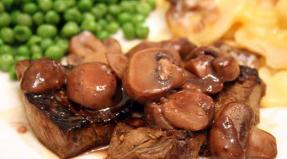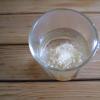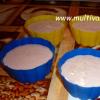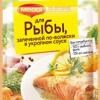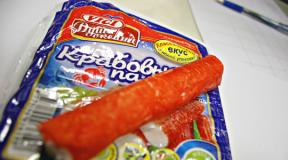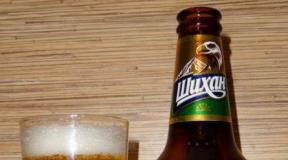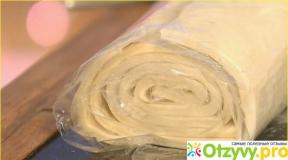How to boil milk so it doesn't burn. How to boil milk: dishes, time, tips
Milk and dairy products are an irreplaceable part of our diet. And how many delicious and healthy dishes you can cook from it!
Surely every housewife has repeatedly faced the problems of boiling milk - it runs away, then curls up, then burns. Yes, and many other questions arise, for example, whether to boil milk at all and why do it. It is especially important to understand all this when it comes to milk for a child.
Why boil milk?
Boiling milk is the easiest way to disinfect and increase the shelf life of this product at home. It's no secret that milk is an excellent breeding ground for bacteria. And when heated to 100 degrees, almost all of them die.
Unfortunately, exposure to high temperatures is harmful not only for harmful microorganisms. And even during boiling, some vitamins and microelements are destroyed, and even milk protein is modified. As a result, the beneficial qualities of milk diminish with every minute of boiling. But if you weigh all the pros and cons, then raw milk must be boiled! The only exception may be paired with your own cow, although there is some risk here. 
In general, fresh milk from a healthy cow is a unique product, since the content of all nutrients is increased in it. And besides, it has bactericidal properties due to the special enzyme lisorzim. But already 2 hours after milking, the enzyme is destroyed, and the composition returns to normal, that is, the milk ceases to be steamy. 
All this concerns not only cow's milk - raw goat's milk also needs to be boiled. Sometimes the benefits of goat milk are so exaggerated that it reaches the point of absurdity. For example, it is mistakenly believed that milk from a goat is absolutely safe, therefore it is not necessary to boil it. You should not take such an opinion seriously, at best you can catch an intestinal infection, and at worst - the consequences are simply unpredictable.
What kind of milk you shouldn't boil
So, we already know about the need to boil raw milk purchased from hands. But there is also a store in bags or bottles - what to do with it? 
Remember - you do not need to boil pasteurized, ultra-pasteurized and baked milk! This product has already passed all the necessary decontamination processes in special conditions. By the way, special baby milk does not need to be boiled or heated too much - usually its composition is additionally enriched with vitamins and minerals, which can be destroyed by high temperatures.
You can also find lactose-free milk on supermarket shelves. That is, one from which, with the help of special technologies, a substance harmful to some people was removed - lactose. This type of milk is also not boiled.
If you are planning to make yogurt, homemade kefir or other sourdough delicacy from store milk (pasteurized or ultra-pasteurized), then you should not boil it. It is enough just to warm up to the desired temperature - so more usefulness will remain in the finished product.
You can find yogurt recipes at.
We boil correctly
Now about the rules for boiling. First, choose the dishes. To prevent the milk from burning, it is better to take an aluminum container, glass, ceramic or stainless steel. 
- rinse the pan with cold water;
- put on fire, burbot 70-100 ml of ordinary water;
- as soon as the water boils, pour in a little milk;
- if the milk, boiling, does not curl, then you can add the rest;
- over medium heat, stirring occasionally, bring to a boil;
- we reduce the fire;
- turn off after 1-2 minutes.
Do not keep on fire for more than 2 minutes - this is quite enough time for pathogenic microorganisms to die. The longer we boil, the less usefulness remains.
By the way, if you put an ordinary inverted saucer on the bottom of the pan, the milk is unlikely to run away and will definitely not burn.
There is another trick - grease the inside of the pan with oil just above the milk level.
And this video shows another interesting and effective way:
Boiling in the microwave
You can boil milk in the microwave, but there is no clear recipe - a lot depends on the volume of liquid and the power of the microwave oven. On average, 3 liters of milk boils in 10 minutes. But here it is important to understand - most likely, the milk will run away. I just put the cup or saucepan in a high-rimmed glass bowl. 
By the way, for those who believe in fairy tales about the dangers of microwaves: recent research by scientists has confirmed that cooking in a microwave oven has absolutely no effect on the molecular structure of foods. That is, in terms of benefits, the microwave is no more dangerous than an ordinary stove.
Correcting errors
If the milk still burns during boiling, then you can try to remedy the situation as follows:
- immediately pour it into another pan;
- add ordinary salt at the rate of 0.5 tsp. 2 liters;
- quickly lower it into a basin of cold water.
Of course, such milk should not be given to children, and even more so to infants. Better to use it for pancakes, baking.
Is there anything you can do if the milk is curdled? Unfortunately no. But if you throw this mass into 2 layers of gauze, and let the resulting whey drain, you get the most delicate cottage cheese without any sour taste. 
taking this opportunity, I will give a link to mine.
Hope that all this information will help bring milk to a boil so that nothing has to be corrected.
In the world of modern and convenient technologies, natural products are more and more appreciated. Pasteurized milk on store shelves is ready to drink - it doesn't need to be boiled. Just open the pack and enjoy the taste. In addition, it does not deteriorate for a long time and can stand in the refrigerator for weeks. Have you ever wondered why production milk does not spoil for so long? Surely, in its composition and on the walls of the package there are special preservatives that seem to freeze the properties of milk. The drink becomes dead - no nutrients remain in it. That is why many housewives try, whenever possible, to buy "live", natural milk from a cow. However, there are risks here too. For milk to be safe and usable, it must be boiled.
Dangers of "raw" milk
The fact is that harmful microorganisms can get into milk at any stage of its production. An unscrupulous milkmaid may start milking the cow with dirty hands. The dishes into which the milk is being milked may also not be clean enough. In addition, germs and harmful bacteria can enter the container during the milk transport phase.
However, even if you have a cow at home and you are absolutely sure that the dishes and hands of the milkmaid are clean, the milk must certainly be boiled. The fact is that a cow can get sick, even if it does not manifest itself in any way outwardly. Any changes in the animal's diet can also change the composition of the milk. As they say, God takes care of the saved, so do not drink fresh milk. And especially, do not give it to children.
Boiling milk not only protects you from harmful microorganisms, but also significantly increases the shelf life of the product. If raw milk is stored in the refrigerator for no more than three days, then boiled milk may well stand for a week.
This process is not complicated, and even the most inexperienced hostess can handle it. However, there are several nuances that will help you avoid burning and escaping milk.
- The milk should be boiled as soon as you bring it home. The sooner you do this, the longer the product will last.
- If you get milk from an unverified vendor, check the product for quality. To do this, put a drop of milk in a glass of cold water. If the drop immediately begins to dissolve, the product is diluted with water. If the drop sank to the bottom, the milk is good.
- First you need to decide on the dishes in which you are going to boil the milk. A glass, aluminum, or steel pot is suitable for boiling. Milk will burn in an enamel bowl.
- Rinse the boiling pot and pour some clean water (one cup) into it. When the water boils, add a little milk to it. This is done to test the milk for freshness. If the milk starts curdling, it’s sour - it’s better not to boil it. Pancakes or pancakes can be made from such milk, but it is not recommended to drink it in its pure form. If the milk is not curdled, you can add the rest of the product. Don't worry about diluting the milk with a little water - it will evaporate quickly.
- It is better to boil milk in a saucepan with high sides so that it does not run away. If the container is completely filled with milk, you can put an inverted saucer on the bottom. It prevents violent boiling, which protects the milk from escaping.
- A saucepan with milk should be put on a low heat and be nearby all the time. Stir the container from time to time to warm up the milk evenly. Skim off the froth before the milk starts to boil. Then, after boiling, you do not need to remove the foam - the most useful microelements are collected in it.
- How much to boil milk so that it retains its beneficial properties, but all harmful microorganisms have been destroyed? Boil milk for at least two minutes. When the liquid is hot enough and the foam starts to creep up, simply reduce the heat to low. The milk should boil, but not escape. Two minutes is enough to get rid of pathogenic microbes and bacteria. If you want to get thicker, richer and more fatty milk, boil it for at least half an hour.
- After boiling, milk does not need to be poured into a jar immediately. Let it cool at room temperature and then put it in the refrigerator.
This method of boiling will allow you to prepare the food for safe use.
We've put together a variety of milk-related educational tips for you.

- To prevent the milk from escaping and burning, you can use ordinary butter instead of a saucer at the bottom. Just grease the edges of the dishes with it just above the edge of the milk and the liquid will not overcome this obstacle.
- If you notice small pieces of hay in the milk (and if the product is natural, this may well happen), you just need to strain the liquid through several layers of gauze.
- Do not leave the stove while the milk is heating there. Find something to do in the kitchen. This way you will not miss the moment when the milk is ready to "run away".
- Add some sugar to the milk to increase its shelf life.
- You do not need to boil pasteurized and UHT milk that is sold in the store - it is already ready for use. The same applies to special milk bags for children.
- If you forget to test the milk for freshness and it is completely curdled, do not despair. Boil the milk for a few more minutes, and then put the liquid on cheesecloth. You will get delicious (absolutely not sour) cottage cheese and whey, from which airy and delicate pancakes are obtained.
- If you bought too much milk and are afraid that you will not have time to drink it, make condensed milk from it! Natural, thick and insanely delicious as before. To do this, add a couple of cups of sugar to two liters of milk and cook over low heat for at least 3-4 hours.
- Stir the milk regularly to prevent it from burning. To facilitate and speed up the process, you can simmer milk with sugar in a multicooker. There it will not burn, it will not need to be monitored so carefully. As a result, you will receive 700-800 ml of a natural product without any preservatives, which you can safely give to your child.
- If the milk burns during boiling, it should be immediately poured into a clean container, which is then lowered into a bowl of cold water. Add a pinch of salt to the milk and stir. This will remove the rancid taste and odor from the drink.
- Store milk in an airtight container, as this product easily absorbs foreign odors.
- Do not leave milk in direct sunlight. Light deprives the product of vitamins A and E.
These simple tips will help you boil, store and consume milk properly.
Milk and dairy products are the main component in the diet of any person. Along with meat products, cereals, vegetables and fruits, milk is an integral part of human nutrition. It contains a huge amount of vitamins and minerals. Drink milk and take care of your health!
Video: how to boil milk
Many housewives are used to boiling milk without hesitation, especially if it is intended for small children. Let's see if boiling is really necessary and what are the subtleties of this process.
Why boil milk?
Boiling helps to disinfect raw milk by ridding it of bacteria. Like any product, it is a fertile breeding ground for harmful microorganisms that die during heat treatment. And since the bacteria are destroyed, then boiled milk is stored longer than raw milk.
Boil or not?
True, this procedure has its drawbacks. The high temperature not only destroys bacteria, but also destroys the vitamins and trace elements contained in unpasteurized milk, and also changes the structure of milk protein. The longer the product is cooked, the less vitamins remain in it. Nevertheless, even after this procedure, a sufficient amount of nutrients remains in the milk. But if you don't boil milk bought from your hands, there is a risk of contracting some unpleasant disease, for example, E. coli or salmonella. So be sure to boil unpasteurized milk!
Milk from the store
So, a product bought in the market or from a village grandmother must be boiled. But what about milk from a store or a hypermarket? This product has already passed all the stages of heat treatment by the time it appeared on the store shelf, and is completely ready for use. If the package indicates that it is UHT or melted, there is no need to boil it. The same applies to infant formula - as a rule, they are enriched with vitamins and minerals necessary for the child, which can be destroyed during heat treatment. In some stores, you can also see lactose-free sterilized milk. It is suitable for people with milk sugar intolerance. Such a product does not need to be boiled either.

Choosing utensils for boiling
How to boil milk? In what kind of dish is it better to do it? The bottom of the pot for boiling should be thick or even double, this reduces the likelihood of sticking. As for the material, it is preferable to take stainless steel dishes. If there is no one on the farm, an aluminum, glass or ceramic container is also suitable. But it is not recommended to use it - milk can easily burn in it, and it will not be easy to wash such a container. By the way, some manufacturers of kitchen appliances produce milk cookers created exclusively for this procedure.

How to boil?
How to boil milk? Rinse the pot with cool water before placing it on the stove to save the food from burning. If you place a small saucer on the bottom of the dish, the milk will probably not run away: by tapping on the walls and bottom of the container, the saucer will prevent the foam from forming on the surface when the liquid begins to boil.
Place the pot on the stove, pour some water into it and wait for it to boil. Add some milk to the boiling water, and if it is not curdled, pour in the rest. Stir occasionally, bring food to a boil over medium heat, then reduce. After one to two minutes, the pot can be removed from the stove.
During boiling, milk can escape due to the foam that forms on its surface and does not allow the rising air bubbles to burst. You can remove it only during boiling, but not after. It is better to leave the film on the cooled product, since it is this film that contains most of the nutrients.

How long does it take to boil?
How much milk to boil? Nutritionists disagree about how long to boil it. Some doctors recommend doing this for ten minutes or longer to ensure that all harmful microorganisms are destroyed. But many nutritionists advise boiling milk until it begins to boil.
So how much milk should you boil? It is believed that harmful microorganisms will be neutralized even for a short time. In addition, the shorter the duration of the heat treatment of milk, the more nutrients it will retain.
Can I boil in the microwave?
Doctors note that you can also boil milk in a microwave oven. True, after this procedure, vitamins and minerals will remain in it even less than after boiling on the stove.
How to boil milk in the microwave? It is impossible to give an exact recipe for heat treatment of this product in a microwave oven - the duration depends on both the volume of liquid and the power of the unit. In addition, when using a microwave oven, it is difficult to notice the moment when milk starts to overflow, so we recommend pouring it into a glass or other deep container.

- To keep the boiled milk from spoiling for a long time, add a teaspoon of sugar for each liter of the product while it is boiling.
- If desired, the saucer will replace a special circle or "gatehouse" - these devices can be purchased at any hardware store.
- Neither a circle nor a saucer will be needed if the sides of the pan are greased with butter slightly above the milk level, so it will not run away either.
- A pinch of baking soda will keep stale milk from curdling if you need to boil it.
- If the milk does burn, transfer it to another container, adding half a teaspoon of salt for every 2 liters of product, and put the container in a large container filled with cold water (for example, a basin). It is better not to give burnt liquid to small children, but you can add it to baked goods.
- If you do not intend to drink milk immediately after boiling, pour it into a tightly sealed container so that it does not absorb odors from other foods and refrigerate.
- The plaque that forms after boiling milk must be thoroughly washed off. It is better to have a separate container in general, which you will only use for this procedure.
- If it is not possible to store sterilized milk in the cold, boil it twice a day (morning and evening) and cover with a lid only after it has cooled completely. This will keep the product for two to three days.
Now you know how to boil milk. We hope this information will be useful to you.
05 Dec 2014I didn’t know where to create this topic. If you move something where you need it))))
For seven years now we have been buying homemade milk from the same people. Before, everything was always fine. For the last three weeks, the milk burns a lot during boiling. We have not tried anything. And the pots changed the sugar and poured water. But it still burns. and, of course, the taste deteriorates. The last time they took a ceramic cauldron and boiled in it. We were so happy that it boiled well and there was no smell, but after it cooled down we were stunned. Poured into a bottle and at the bottom of the cauldron there was a layer of 4 millimeters burnt milk.
What could it be?
I am very worried that they simply began to add something to the milk. But I take it to children. Yoghurts, cereals, all only from home. We talked with the neighbors, they say the same problem.
Tomorrow these people will come again to sell milk. I want to come up to talk, but I need to stock up on information)) To be clever if anything))))
Photo from the Internet.But that's how it always works now.
Post has been edited by supermama: 05 December 2014 - 11:56
It seems to me that if you are in doubt, it is better to refuse. Health is more expensive. My milk does not burn, because I have a special aluminum pan with a double bottom)))) But I noticed that from different milk at the bottom there are more or less grains of some kind, like semolina.
I also took homemade milk until I put it on yogurt, and it stood for a couple of days fermented with sour cream, warm and not sour. Before that, yogurt always turned out fine. I began to suspect the addition of antibiotics. And she dug up what could be if the cow was fed incorrectly, i.e. excess protein feed. And all would be fine, but such milk is VERY HARMFUL for humans (a lot of ketone bodies accumulate in it). I stopped taking homemade milk and switched to store milk. Of course, there is no guarantee either, maybe they buy from the same private traders in villages. But I want to believe that at least some kind of control is exercised and quality is monitored in production. I take Saki milk, it seems to me it smells like the milk that they gave us at school after the 1st lesson))))
Post has been editedtutsi: 06 December 2014 - 01:43
11 Dec 2014
To prevent milk from burning, firstly, you need a good aluminum saucepan, and secondly, you need to add a little water to the saucepan, as my grandmother taught me, and thirdly, you need to stir more often, do less fire and nothing will burn.
Post has been edited Orange: 11 December 2014 - 06:04
12 Dec 2014
In general, they told me that their cow is about to calve and this is why this is happening with milk. This time I boiled it again in a ceramic cauldron through a divider. For a long time, of course, it’s burnt anyway. But not so much already.
21 Dec 2014
In general, they told me that their cow is about to calve and this is why this is happening with milk.
if they say that, then
firstly, these are unscrupulous sellers. When a cow is launched, her milk is not sold because it is inferior in quality.
secondly, you can easily check it. The milk will taste a little salty. And it will turn sour for a very long time.
today I will go to my neighbor for milk, she understands these issues, I will definitely ask her
Of course, there is no guarantee either, maybe they buy from the same private traders in villages. But I want to believe that at least some kind of control is exercised and quality is monitored in production. I take Saki milk, it seems to me it smells like the milk that they gave us at school after the 1st lesson))))

